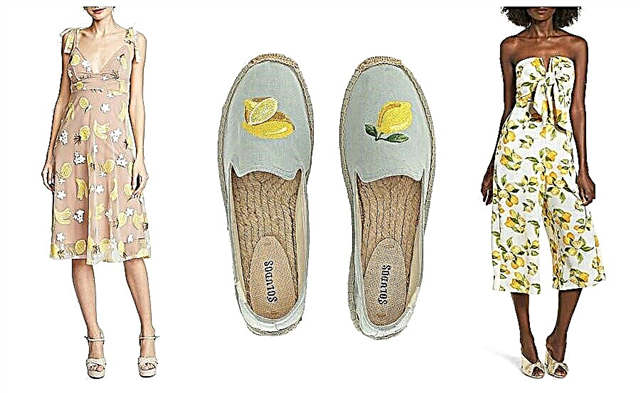Share
Pin
Tweet
Send
Share
Send
The seam assemblies will give our striped pullover a dizzying look!
Besides: • silk paper for transferring patterns from a sheet of patterns; • pencil, paper scissors; • tape measure; • tailor pins; • tailor's chalk; • scissors for cutting and small scissors for needlework; • burda carbon paper, cutter for pattern translation; • needle of the sewing machine, double needle of the sewing machine with a distance between the needles of 2 mm and a manual needle for sewing.
Recommended fabrics: only elastic knitted fabrics.
 The length from the waist is 30 cm (along the line of the middle of the front).
The length from the waist is 30 cm (along the line of the middle of the front).Sleeve approx. 10 cm longer than standard.
Pullover pattern pink, so it is easy to find on the sheets of patterns. Put silk paper on a sheet of patterns and pin it. Translate the details of the pattern of your size along the corresponding contour lines and do not forget about the marking and inscriptions. Glue parts 2 and 2a, as well as 3 and 3a along the connection lines. A special paper pattern is not provided for turning the neck. The hem should be cut right on the knitted fabric. Dimensions are shown on the right.
Extra tip: pullover size is determined by the circumference of the chest (size 34 = 80 cm, size 36 = 84 cm, size 38 = 88 cm, size 40 = 92 cm, size 42 = 96 cm, size 44 = 100 cm).

Extra-pattern of pink color on the sheets of patterns, A and B
A: details 2, 3 and 3a
B: parts 1 and 2a
 Layout plan shows how to arrange the details of a paper pattern on a knitted fabric. Pin the details of the paper pattern.
Layout plan shows how to arrange the details of a paper pattern on a knitted fabric. Pin the details of the paper pattern.1 Before 1x
2 + 2a Back 1x
3 + 3a 2x sleeve
and) neckline length: sizes 34, 36, 38 - 55 cm, sizes 40, 42, 44 - 60 cm and a width of 4 cm, including allowances.
 1. OPEN FRONT AND BACK
1. OPEN FRONT AND BACKLay the knitted fabric in one layer face up. Put the details of the paper pattern 1 and 2 on the knitted fabric with the inscription side up, line the stripes on the details of the paper pattern with the same stripes of the knitted fabric, pin it. Mark around the parts of the paper pattern with tailor's chalk allowances: for hemming 3 cm, for the remaining seams and for cuts 1.5 cm. On the knitted fabric, draw a neckline (a). Cut out the details.
 2. OPEN SLEEVES
2. OPEN SLEEVESFold the knitted fabric in half with the front side inward, aligning the strips. On a folded double knitted fabric, apply the detail of the paper pattern 3, pin it. Mark around the details of the paper pattern with tailor's chalk allowances: 3 cm for bottom hem, for other seams and 1.5 cm for cuts. Cut out the details.

3. SEAM LINES AND STAMPING
The lines of seams and lower edges on the details of the cut can not be translated. For transverse marks for threading the sleeves on the front and the sleeves (reference marks 5), as well as for the star marks (for assembling), make notches from the edges of the allowances of 5 mm in length.

4. FLISELINE FORMBAND
Press the non-woven fabric bands along the sections of the in-sleeve hoses (wrong side) so that the chain seam on the non-woven fabric lies at a distance of 1.3 cm from the edges of the allowances.
 5. ASSEMBLIES
5. ASSEMBLIESAlong the right side cuts of the front and back (back side) and on the front along the cut of the left-hand sleeve in between the notches (step 3), sew machine stitches with large stitches 12 mm from the edges of the allowances. At a distance of 5 mm from these lines, lay another 1 line. Firmly hold the lower threads of the stitching for the side cuts, pull the side cuts on the stitching threads to a length of 28 cm. Tie the stitching threads. Distribute the assembly evenly. Cut in the sleeve until it is tightened.
 6. LATERAL SEAMS
6. LATERAL SEAMSPlace the back on the front side to the front side, chip side sections.Pin the elastic tape (flamilastic) over the stitching lines of the side sections. Sew side sections with allowances of 1.5 cm wide with a special elastic or narrow zigzag stitch (stitch length - 2 mm, stitch width - 0.5 mm) to maintain the elasticity of the seams. Overlock the seams of each seam and iron on the back.
 7. SEAMS OF SLEEVES, FITTING NIZA
7. SEAMS OF SLEEVES, FITTING NIZAFold each sleeve along the front inward. Chop the sleeve sections, grind with allowances 1.5 cm wide. Seam the seam allowances together and iron forward. Overlock the hem of the bottom of the pullover and the bottom of the sleeves, iron on the wrong side, at the left side seam on the allowance, lay a fold. Sew the lower edges from the front with a double needle at a distance of 2.5 cm, while the stitch along the lower edge of the pullover should start / end at a distance of approx. 3 cm from the right side seam.
 8. HARNESSING
8. HARNESSINGKnit the sleeves with cuts on the armhole with the front sides, the left sleeve is only above and below the assembly marks so far. Hold the lower threads of the stitching stitches tightly, pull the left armhole on the stitch threads to the size of the sleeve, pin the armhole in front with the sleeve. Tie the stitches. Stitch the sleeves with allowances 1.5 cm wide. Overlock the seams of each stitching seam together and iron from the top to the beginning of the rounding of the armhole on the sleeve.
 9. NECK
9. NECKFold the neckline (a) along the front half in half. Iron. Pin the grind to the neck cut on the front side so that the open cut slices lie 5 mm from the edge of the allowance along the neck cut. Lay a stitch along the neckline at a distance of 1 cm from the open cuts of the facing. Cut the seam allowances close to the stitch. Unscrew the obtachka on the wrong side, take it. Iron the neck and stitch at a distance of 5 mm.
PHOTO: U2 / ULI IGLAZEMAN. ILLUSTRATIONS: IELKE TRETAYER-SHAFER. TEXT: HYDEMARI TENGLER
Material prepared by Julia Dekanova
Share
Pin
Tweet
Send
Share
Send






